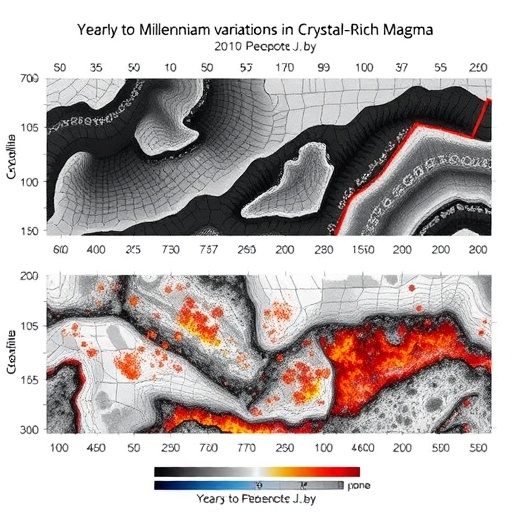In a groundbreaking study that promises to reshape our understanding of volcanology, researchers Higgins, Stock, and Geist delve into the captivating realm of magma storage zones, specifically focusing on the annual-to-millennial fluctuations observed within these structures. The article published in Commun Earth Environ in 2025 sheds light on the intricate and dynamic processes that govern the physical properties of crystal-rich magma, offering insights that are vital not only for academic communities but also for hazard management in volcanically active regions.
Magma storage zones are repositories for molten rock beneath the Earth’s surface, playing a pivotal role in volcanic activity. The authors explore the complexity of these systems, highlighting how varying temperatures, pressures, and chemical compositions dynamically influence the behavior and characteristics of the magma stored within. This study underscores the volatility and unpredictability inherent in magma bodies, which can yet hold critical clues for forecasting future eruptions.
The researchers employed a multidisciplinary approach, integrating field data with advanced geophysical modeling techniques. By analyzing historical eruption data alongside modern monitoring techniques, they established a framework for understanding the periodic changes that occur in magma storage zones. These fluctuations are not just random; they can be tied to broader geological cycles that span thousands of years, making this research relevant for understanding the geological history of our planet.
One of the critical discoveries highlighted in this study is the impact of crystal content on the physical properties of magma. Crystals not only influence the viscosity of the magma, making it more resistant to flow, but also affect gas retention capabilities. This dynamic interplay of factors can lead to variations in eruption styles, ranging from effusive lava flows to explosive pyroclastic eruptions, presenting a complex challenge for volcanologists.
The research findings reveal that as the crystal content within magma changes, so too does its behavior beneath the surface. These changes can occur on multiple temporal scales, creating varying eruption styles that pose different risks to surrounding areas. By establishing a clear connection between crystal-rich zones and eruption dynamics, the authors advocate for a refined approach to monitoring and predicting volcanic activity.
Another fascinating aspect of the study involves the geological implications of these fluctuations. The authors suggest that patterns of magma storage and release may provide insights into the Earth’s thermal and mechanical evolution over time. This understanding expands not only our knowledge of volcanology but also our grasp of the Earth’s dynamic systems as a whole.
Key to the research is the deployment of sophisticated imaging techniques, which allow scientists to visualize the internal structures of magma storage zones. Using advanced methods such as seismic tomography, the researchers were able to map the distribution and movement of magmatic materials beneath the surface. This innovative approach provides a clearer picture of how these subterranean reservoirs influence volcanic activity.
While the study encapsulates a wealth of technical insights, it also emphasizes the importance of collaboration among scientists, geologists, and emergency management professionals. Their collective efforts are essential to develop comprehensive volcanic hazard assessments, which are crucial for communities living in proximity to active volcanoes. Enhanced understanding of magma behavior can contribute to more effective monitoring systems and early warning mechanisms that could save lives.
The implications of this research extend beyond just academic circles. As natural disasters continue to pose significant risks to human life and infrastructure, the information gleaned from studying crystal-rich magma storage zones may serve as a blueprint for more robust disaster preparedness strategies. The potential for targeted assessments and tailored responses could mitigate the impacts of volcanic eruptions on communities.
Additionally, the authors of this study argue that integrating data from multiple sources, including geochemical analyses and historical records, will strengthen predictive models. This comprehensive data amalgamation will aid not only in understanding current volcanic activity but also in recognizing patterns from past events that could foreshadow future eruptions.
With the combination of new technologies and innovative research methodologies, it becomes clear that the once mysterious processes governing magma movement and behavior are beginning to unveil their secrets. As scientists continue to collaborate and share knowledge, the quest to understand the Earth’s inner workings is being revolutionized.
Ultimately, the research by Higgins and colleagues serves as a foundational piece that invites further exploration into magma dynamics. Their meticulous analysis paves the way for future studies that could refine our understanding of volcanic systems and their potential hazards. This work exemplifies the intersection of fundamental research and its application to real-world challenges, making it a vital contribution to both the scientific community and society at large.
With the study set to be published in Commun Earth Environ, it emphasizes an urgent call to action for the integration of scientific inquiry with practical application. As the authors conclude, an enhanced understanding of the fluctuating nature of magma storage zones is paramount in navigating the complexities of volcanic behavior, ensuring that communities are better prepared for dealing with nature’s most formidable forces.
Subject of Research: Fluctuations in the physical properties of crystal-rich magma storage zones.
Article Title: Annual-to-millennial fluctuations in the physical properties of crystal-rich magma storage zones.
Article References: Higgins, O., Stock, M.J., Geist, D. et al. Annual-to-millennial fluctuations in the physical properties of crystal-rich magma storage zones. Commun Earth Environ (2025). https://doi.org/10.1038/s43247-025-02982-y
Image Credits: AI Generated
DOI: 10.1038/s43247-025-02982-y
Keywords: magma, volcanology, hazard management, crystal-rich zones, eruption dynamics, geophysical modeling, volcanic activity, geology.




